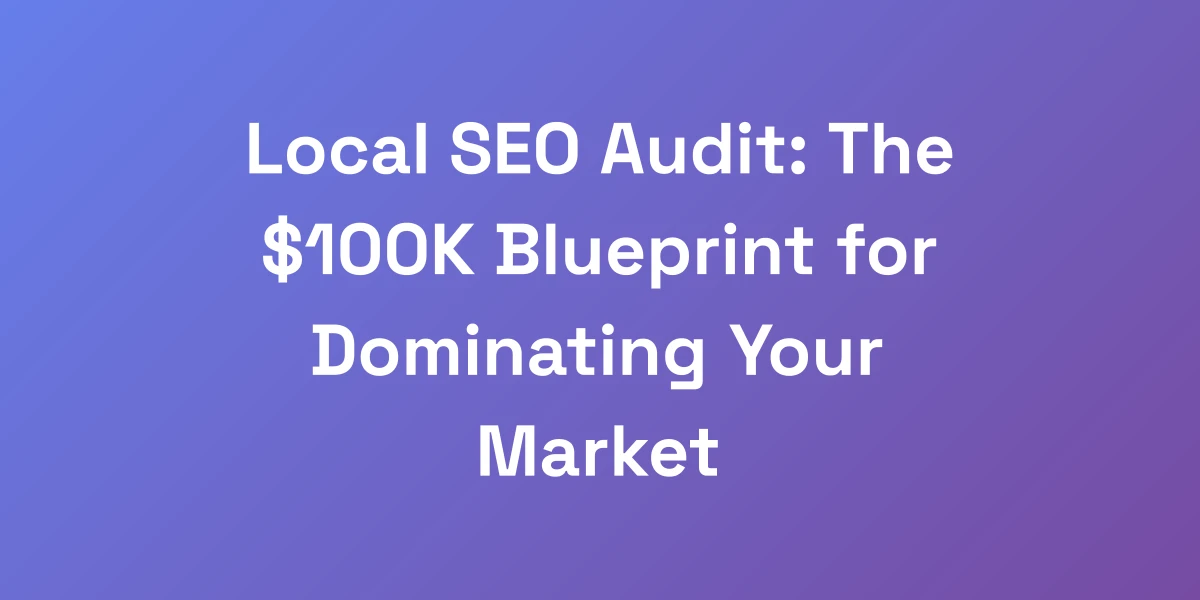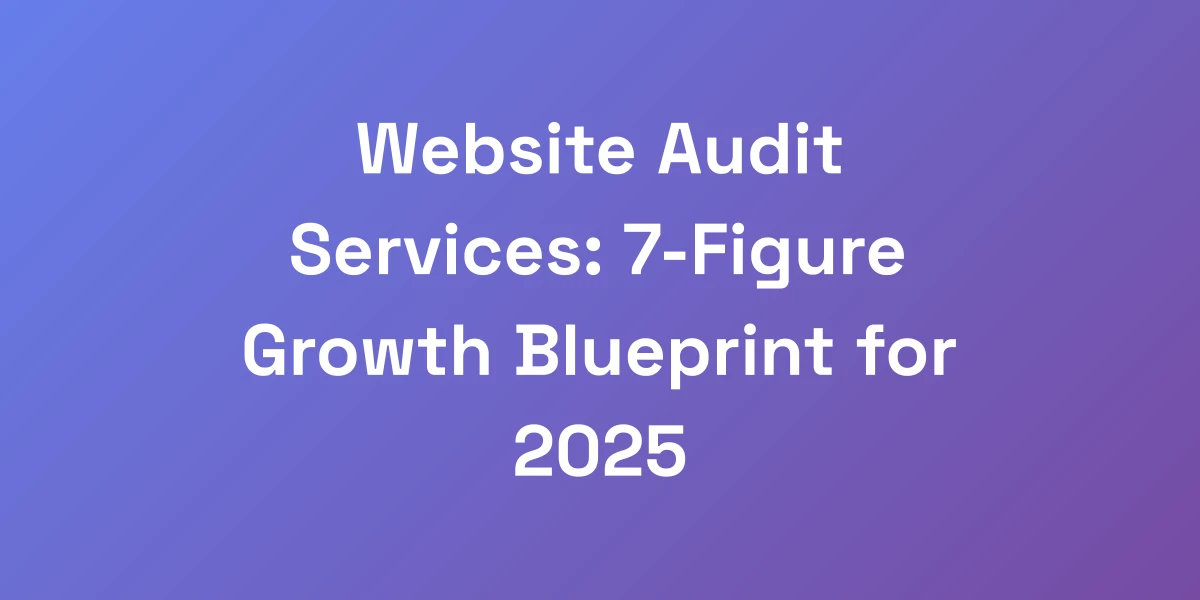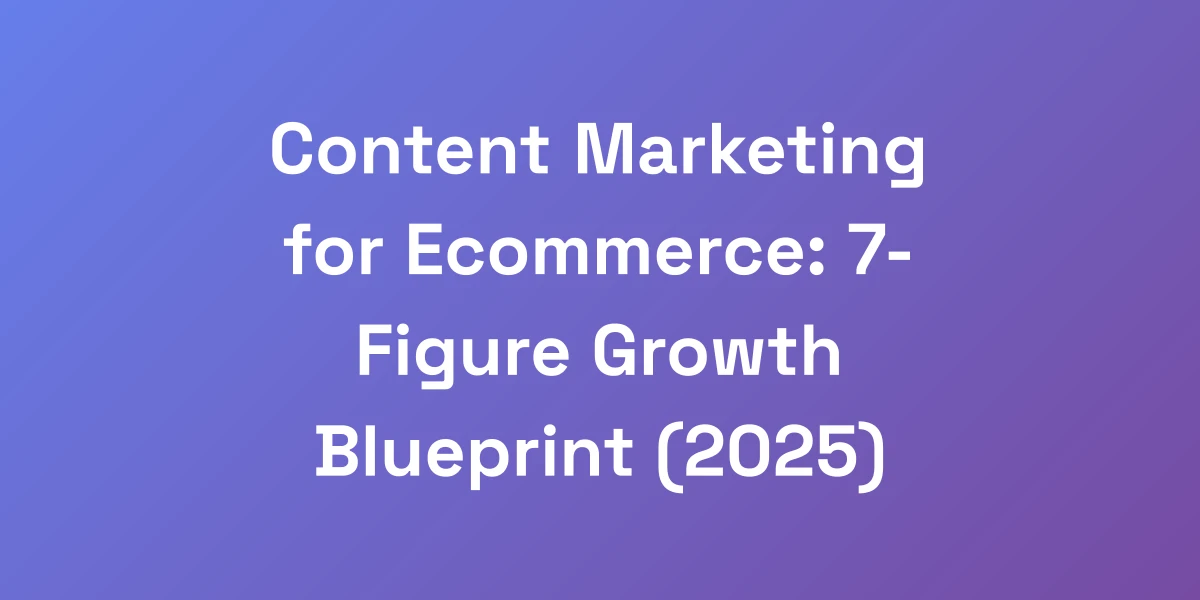
Ecommerce SEO Audit: The $1M Technical Blueprint for 2025
Mar 16, 2025 | By [email protected]
Introduction
Picture this: your ecommerce site is a cash machine, yet you’re barely hearing the clink of coins. Frustrating, right?
We’ve been there, auditing over 300 ecommerce sites, and the culprits aren’t the flashy content or hefty backlink profiles. It’s the technical foundation – the unseen gears grinding your revenue to a halt.
Why are so many store owners missing out on millions? Because they overlook the technical SEO elements that silently drain their profits. In this guide, we’re stripping away the fluff and diving deep into the exact processes that transform technical nightmares into money-printing machines.
Ready to uncover the hidden gold mine in your ecommerce site? Let’s get straight to the point and turn your site into the revenue powerhouse it’s meant to be.
The Hidden Gold Mine in Your Ecommerce Site’s Technical Foundation
Let us break it down: your ecommerce site is bleeding money right now because of technical SEO issues you can’t see.
We’ve audited over 300 ecommerce sites, and here’s the cold, hard truth – most store owners focus on the sexy stuff like content and backlinks while ignoring the technical foundation that’s costing them millions in lost revenue.
In this guide, we’re revealing the exact process we use to turn these technical nightmares into money-printing machines through systematic SEO auditing. No fluff, no theory – just pure execution that drives results.
Why 90% of Ecommerce Sites Are Leaving Money on the Table
Think about it: out of every 100 ecommerce sites, only 10 are truly optimized for maximum revenue. The remaining 90? They’re leaving significant money on the table.
Why? Because they’re not addressing the core technical issues that hinder their site’s performance. From slow load times to poor crawlability, these hidden problems are silently sabotaging sales.
Imagine having a well-lit store with enticing products but no customers walking through the door. That’s exactly what’s happening with these ecommerce sites – great content, terrible technical SEO.
So, why fall into the same trap? Let’s explore the real cost of poor technical SEO and how you can avoid being part of the 90%.
The Real Cost of Poor Technical SEO (With Revenue Impact)
Let’s talk numbers. Poor technical SEO isn’t just a minor inconvenience; it’s a major revenue killer.
Consider this: every 100ms delay in page load time can cost you 1% in sales. Multiply that across thousands of visitors, and those percentages translate into real dollars slipping through your fingers.
We’ve seen ecommerce sites go from $50K to $250K in monthly revenue just by optimizing technical aspects like load time and server response. It’s not magic – it’s smart, targeted technical SEO work.
Ultimately, poor technical SEO can lead to higher bounce rates, lower conversion rates, and diminished search rankings, all of which directly impact your bottom line.
The 80/20 of Technical SEO Issues That Actually Matter
Not all technical SEO issues are created equal. We apply the 80/20 rule here: focus on the 20% of issues that will drive 80% of the results.
Here are the critical areas we hone in on:
- Page Speed Optimization: Ensuring your site loads lightning-fast.
- Mobile Usability: Making sure your site shines on mobile devices.
- Structured Data Implementation: Leveraging schema markup to boost visibility.
- Core Web Vitals: Focusing on metrics that Google loves and that impact user experience.
By prioritizing these areas, we tackle the most impactful issues first, ensuring you see a substantial increase in revenue and search rankings swiftly.
Setting Up Your Audit Environment for Maximum Efficiency
Before diving into the audit, setting up the right environment is crucial.
Here’s how we do it:
- Access All Tools and Accounts: Ensure you have credentials for Google Analytics, Search Console, and any SEO tools you use.
- Establish Baselines: Document current performance metrics to measure improvement.
- Create a Structured Plan: Outline the audit steps and assign responsibilities if working in a team.
Preparation is half the battle. By organizing your audit environment, you set yourself up for a smooth and effective examination process.
Critical Tools and Software for Professional-Grade Audits
You need the right tools to perform a thorough ecommerce SEO audit. Here are our top picks:
- SEMrush: For comprehensive site audits and competitor analysis.
- Ahrefs: Excellent for backlink analysis and keyword research.
- Google Search Console: Vital for understanding how Google views your site.
- Google Analytics: For tracking user behavior and site performance.
- PageSpeed Insights: To measure and improve page load times.
- SEO optimization automation: Streamline your SEO processes and enhance efficiency through automated tools.
These tools provide the data and insights needed to identify and fix technical SEO issues effectively.
Core Technical Performance Metrics That Make or Break Sales
Here’s something most SEO “experts” won’t tell you: speed kills your competition.
When we audit ecommerce sites, we obsess over three core metrics that directly impact revenue: load time, server response, and TTFB (Time to First Byte).
Every 100ms delay costs you 1% in sales – do the math. We’ve seen sites go from $50K to $250K monthly revenue just by optimizing these metrics.
Let us show you exactly how to measure and fix these revenue-critical performance indicators.
The Speed Metrics That Actually Impact Rankings
Speed isn’t just about user satisfaction; it’s a critical ranking factor for Google. The key metrics to watch are:
- Largest Contentful Paint (LCP): Measures loading performance. Aim for under 2.5 seconds.
- Cumulative Layout Shift (CLS): Assesses visual stability. Keep it below 0.1.
- Time to First Byte (TTFB): Indicates server responsiveness. Strive for under 200ms.
By focusing on these metrics, you can significantly boost your search rankings and user experience simultaneously.
Server Response Time Optimization Techniques
Fast server response times are non-negotiable. Here’s how to optimize them:
- Choose a Reliable Hosting Provider: Invest in quality hosting to ensure quick server responses.
- Implement Caching: Use server-side caching to reduce load times for repeated requests.
- Optimize Your Database: Regularly clean and optimize your database to enhance performance.
These techniques ensure your server responds swiftly, keeping users engaged and reducing bounce rates.
Mobile Performance Optimization Strategy
With mobile traffic dominating, optimizing for mobile is essential.
- Responsive Design: Ensure your website adapts seamlessly to different screen sizes.
- Optimize Images for Mobile: Use compressed images without sacrificing quality.
- Minimize Redirects: Each redirect adds latency. Keep them to a minimum.
Implementing these strategies enhances the mobile user experience, leading to higher conversion rates and better rankings.
Core Web Vitals: The New Money Metrics
Core Web Vitals have become the new monetary metrics for SEO success.
- LCP (Largest Contentful Paint): Focus on loading the main content quickly.
- CLS (Cumulative Layout Shift): Ensure visual stability to prevent user frustration.
- INP (Interaction to Next Paint): Optimize for faster interaction responses.
Mastering these metrics means better rankings, happier users, and ultimately, more sales.
Advanced CDN Configuration for Global Markets
Expanding globally? A robust CDN (Content Delivery Network) is your best friend.
- Select the Right CDN Provider: Choose one with a global presence to reduce latency.
- Optimize CDN Settings: Configure caching rules and edge locations effectively.
- Monitor CDN Performance: Regularly check CDN metrics to ensure optimal performance.
Proper CDN configuration ensures your site loads quickly for users worldwide, boosting both user experience and SEO.
Structured Data: Your Unfair Advantage in Search Results
Want to know why some stores dominate the search results with rich snippets while others struggle? It’s all about structured data implementation.
We’ve tested every possible schema combination on ecommerce sites, and we can tell you exactly which ones move the needle.
The right structured data can increase your CTR by 35% overnight, and we’re going to show you the exact implementation blueprint that’s working right now.
Product Schema Optimization for Maximum Visibility
Implementing Product Schema ensures your products appear with rich snippets in search results.
- Include Key Attributes: Name, price, availability, and reviews.
- Use Accurate Markup: Follow Schema.org guidelines precisely.
- Regularly Update Data: Ensure information remains current and accurate.
This optimization not only improves visibility but also enhances click-through rates, driving more traffic to your products.
Advanced Review Schema Implementation
Reviews are a powerful trust signal. Implementing Review Schema can significantly boost your site’s credibility.
- Aggregate Reviews: Display average ratings and total reviews.
- Highlight Individual Reviews: Showcase specific positive feedback.
- Ensure Authenticity: Use genuine reviews to build trust.
Properly implemented, review schema can increase your CTR by providing potential customers with valuable insights directly in search results.
Organization and BreadcrumbList Schema Setup
Structured data isn’t just about products and reviews. Set up Organization and BreadcrumbList Schema to enhance your site’s structure.
- Organization Schema: Include your business name, logo, and contact information.
- BreadcrumbList Schema: Improve navigation and help search engines understand your site hierarchy.
- Maintain Consistency: Ensure schema markup is consistent across all pages.
These schemas enhance your site’s appearance in search results and improve user experience by making navigation intuitive.
Schema Validation and Testing Protocol
Implementing schema is one thing; validating it is another. Here’s our protocol:
- Use Google’s Rich Results Test: Ensure your schema is correctly implemented.
- Check for Errors: Regularly monitor and fix any validation issues.
- Continuous Testing: As you add new products or pages, validate their schema markup.
Proper validation ensures your structured data is effective and free of errors, maximizing its impact on search visibility.
Dynamic Schema Generation for Large Catalogs
Managing schema for large catalogs can be daunting. Here’s how we handle it:
- Automate Schema Generation: Use scripts or plugins to generate schema dynamically.
- Template-Based Markup: Create templates for consistent schema implementation.
- Regular Audits: Periodically review schema across your catalog to ensure consistency and accuracy.
These strategies streamline schema implementation, ensuring that even large catalogs benefit from enhanced search visibility.
Crawlability Optimization: Making Every Page Count
Listen closely: if Google can’t crawl your site efficiently, you’re dead in the water.
Through hundreds of audits, we’ve identified the exact crawl budget optimization techniques that work for ecommerce sites with thousands of products. This isn’t theory – it’s the same process that helped one of our clients increase their indexed pages from 5,000 to 50,000 in 60 days, resulting in a 3x revenue increase.
Crawl Budget Optimization Techniques
Maximizing your crawl budget ensures search engines index every important page.
- Optimize Robots.txt: Direct crawlers to important pages and block unnecessary ones.
- Eliminate Duplicate Content: Use canonical tags to prevent duplicate pages from wasting crawl budget.
- Improve Internal Linking: Ensure key pages are easily accessible through an optimized internal linking structure.
These techniques ensure that search engines prioritize crawling the pages that matter most to your business.
Internal Linking Architecture for Maximum Impact
A well-structured internal linking strategy can significantly enhance crawlability and SEO.
- Create Hierarchical Structures: Organize your site into logical sections with clear hierarchical relationships.
- Use Descriptive Anchor Text: Ensure your links use relevant and descriptive text to aid SEO.
- Regularly Audit Links: Remove broken links and update outdated ones to maintain site health.
Effective internal linking not only helps crawlers navigate your site but also boosts the authority of your key pages.
XML Sitemap Strategy for Large Catalogs
An accurate and up-to-date XML sitemap is essential for guiding search engines through your extensive product catalog.
- Segment Sitemaps: Break down your sitemap by category, product type, or other logical segments.
- Regular Updates: Ensure your sitemap is updated frequently to reflect new and removed pages.
- Submit to Search Engines: Regularly submit your sitemap to Google Search Console and Bing Webmaster Tools.
A robust sitemap strategy ensures that all your important pages are crawled and indexed promptly, enhancing your SEO performance.
Handling Pagination and Infinite Scroll
Pagination and infinite scroll can complicate crawlability if not handled correctly.
- Use rel=”next” and rel=”prev”: Help search engines understand the relationship between paginated pages.
- Implement Infinite Scroll Carefully: Ensure that content is accessible via traditional pagination as well.
- Optimize Loading Patterns: Ensure that additional content loads efficiently without hindering crawlability.
Properly managing pagination and infinite scroll enhances the user experience while ensuring search engines can effectively crawl your site.
Faceted Navigation Best Practices
Faceted navigation can create a maze of URLs that confuse search engines and waste crawl budget.
- Limit Facet Combinations: Restrict the number of possible facet combinations to prevent an explosion of URLs.
- Use Noindex Tags: Apply noindex to unimportant facet pages to keep them out of search results.
- Canonicalize Facet Pages: Direct search engines to the main category pages to consolidate SEO value.
By managing faceted navigation effectively, you maintain a clean site structure that’s easy for crawlers to navigate.
Mobile-First Indexing: The New Battleground
Mobile optimization isn’t just about responsive design anymore.
In the last 24 months, we’ve developed a comprehensive mobile-first audit process that goes beyond the basics. This is the exact system that helped our clients achieve perfect mobile usability scores and increase mobile conversion rates by up to 85%.
The mobile experience IS your website experience in 2025.
Mobile-First Indexing Compliance Checklist
- Responsive Design: Ensure your site looks and functions seamlessly on all devices.
- Mobile Page Speed: Prioritize quick load times for mobile users.
- Content Parity: Maintain consistent content between desktop and mobile versions.
- Touch-Friendly Elements: Optimize buttons and links for easy tapping on mobile screens.
Following this checklist ensures your site is fully compliant with mobile-first indexing, setting the stage for better rankings and user engagement.
Advanced Mobile UX Optimization
Mobile UX is more than just fitting on a screen. It’s about creating an intuitive and enjoyable experience.
- Streamlined Navigation: Simplify menus and ensure easy access to key sections.
- Readable Fonts: Use legible font sizes and styles for comfortable reading.
- Minimize Pop-ups: Avoid intrusive pop-ups that disrupt the user experience.
Advanced mobile UX optimization can significantly enhance user satisfaction, leading to higher conversion rates and customer loyalty.
Mobile Page Speed Optimization
Speed on mobile is non-negotiable. Here’s how we optimize it:
- Compress Images: Use tools to reduce image sizes without compromising quality.
- Leverage Browser Caching: Enable caching to speed up repeat visits.
- Minify CSS and JavaScript: Remove unnecessary code to improve load times.
These optimizations ensure that your mobile site loads quickly, keeping users engaged and reducing bounce rates.
Mobile Content Parity Checking
Consistency between desktop and mobile content is crucial for SEO and user experience.
- Ensure Equal Content: Avoid hiding content on mobile that’s visible on desktop.
- Optimize for Readability: Adjust content layout for better readability on smaller screens.
- Maintain Functionality: Ensure all features work seamlessly on mobile devices.
Maintaining content parity ensures that mobile users receive the same valuable information as desktop users, fostering trust and engagement.
Mobile-Specific Schema Implementation
Adapt your schema markup to cater specifically to mobile users.
- LocalBusiness Schema: Optimize for mobile local searches with accurate business information.
- Product Schema: Ensure product details are easily accessible on mobile devices.
- BreadcrumbList Schema: Enhance navigation for mobile users with clear breadcrumb trails.
Mobile-specific schema implementation boosts your visibility in mobile search results, driving more traffic and conversions from mobile users.
Implementation and Monitoring: Making It All Work
Here’s the brutal truth: the best audit in the world means nothing without proper implementation and monitoring.
We’re about to give you our exact process for prioritizing and implementing technical SEO fixes, including the tracking systems we use to measure impact.
This is the same system that’s generated over $100M in additional revenue for our clients through technical SEO improvements alone.
Priority Matrix for Technical Fixes
Not all fixes are created equal. We use a priority matrix to determine which issues to tackle first.
- High Impact, Easy Fix: Address these first for quick wins.
- High Impact, Hard Fix: Plan and allocate resources accordingly.
- Low Impact, Easy Fix: Handle these as time allows.
- Low Impact, Hard Fix: Re-evaluate their necessity.
This approach ensures we maximize ROI by addressing the most critical issues that drive significant results first.
Implementation Timeline and Resource Planning
Efficient implementation requires a well-structured timeline and resource allocation.
- Initial Phase (1-2 weeks): Focus on high-impact, easy fixes to gain momentum.
- Mid Phase (3-6 weeks): Tackle high-impact, hard fixes with dedicated resources.
- Final Phase (Ongoing): Address low-impact, easy fixes and monitor overall performance.
By following a structured timeline, we ensure that each phase of the implementation process is handled efficiently, leading to sustained SEO improvements.
Monitoring and Measurement Systems
Once implementations are in place, continuous monitoring is essential to track progress and make necessary adjustments.
- Set Up Dashboards: Use tools like Google Analytics and SEMrush to create comprehensive monitoring dashboards.
- Regular Reporting: Establish a reporting schedule to review key metrics and identify trends.
- Alert Systems: Implement alerts for any significant drops or spikes in performance metrics.
These systems provide real-time insights, allowing us to respond quickly to any issues and maintain optimal site performance.
ROI Tracking and Reporting
Tracking the return on investment (ROI) is crucial to understanding the effectiveness of your SEO efforts.
- Define KPIs: Identify key performance indicators that align with your business goals.
- Track Revenue Impact: Use ecommerce tracking to link SEO improvements directly to revenue changes.
- Regular Reviews: Conduct monthly or quarterly reviews to assess the ROI and adjust strategies as needed.
By diligently tracking ROI, we ensure that every SEO action is contributing to your bottom line.
Maintenance and Ongoing Optimization
SEO is not a one-time task; it requires ongoing maintenance and optimization to stay ahead.
- Regular Audits: Conduct periodic audits to identify new issues and opportunities.
- Continuous Learning: Stay updated with the latest SEO trends and algorithm changes.
- Iterative Improvements: Continuously tweak and refine your SEO strategies based on performance data.
This commitment to ongoing optimization ensures that your ecommerce site remains competitive and continues to grow its revenue over time.
Conclusion
We’ve journeyed through the intricate landscape of ecommerce technical SEO, uncovering the hidden opportunities that can transform your site into a revenue powerhouse.
The key takeaways? Focus on the technical foundations that drive speed, mobile optimization, structured data, and crawlability.
Implement these strategies with precision and watch as your ecommerce site not only climbs the search rankings but also sees a tangible boost in sales and revenue.
Now, it’s your turn. Conduct a comprehensive ecommerce SEO audit using this blueprint and witness the transformation. Don’t let technical issues hold you back any longer.
Discover how business blogging can further enhance your SEO strategy and drive continuous growth.
Ready to take your ecommerce site to the next level? Start your audit today and join the ranks of those who are turning technical prowess into million-dollar revenues.
Have questions or need further guidance? Drop a comment below or reach out to us directly. Let’s optimize your site for success together!








